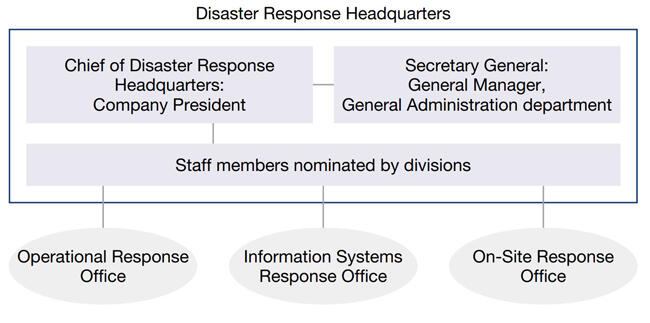- KDDI HOME
 Corporate Information
Corporate Information  Sustainability
Sustainability Safer and More Resilient Connected World
Safer and More Resilient Connected World  Disaster Preparedness
Disaster Preparedness
Disaster Preparedness
KDDI's Approach
As a designated public institution under the Disaster Countermeasures Basic Act, we have formulated a business continuity plan (BCP) for large-scale natural disasters as an emergency response policy to ensure the stable provision of telecommunications services at all times under any circumstance. We are working to build an organizational structure capable of responding to different types of disasters and implementing a suite of measures in partnership with various relevant organizations.
Business Continuity Planning
Our BCP for large-scale natural disasters is based on the principles of ensuring the safety of our employees and their families, performing our responsibility as a designated public institution to ensure the continuity of telecommunications services and supporting our stakeholders. It stipulates a range of measures that cover different stages, from the initial response at the occurrence of a disaster through full-scale restoration to relief activities in the affected areas.
The effectiveness of the BCP is assessed during the twice-yearly disaster preparedness drills, and any issues identified in the exercise are addressed. An annual PDCA cycle is applied in the ongoing effort to strengthen the foundation of our emergency response structure further.
Disaster Response Framework

Establishing a Disaster Response Headquarters in Times of Disaster
Natural disasters are unpredictable and can strike any time. We have defined the criteria for establishing a Disaster Response Headquarters in advance to act proactively in the event of a natural disaster that meets these criteria.
In the event of the Disaster Response Headquarters being established, it will be headed by the President. The headquarters will maintain close communication and work in cooperation with local response offices to lead our efforts to restore damaged networks and facilities as quickly as possible, support the customers in affected areas and offer aid to emergency shelters.
Action against Pandemic Influenza and Other Epidemics
Based on the "Law Concerning Special Measures against New Strains of Influenza, etc." and the "Law Concerning Special Measures against New Strains of Influenza, etc.", we have formulated a "Plan for Maintaining Company-wide Operations in the Event of an Outbreak of a New Strain of Influenza" to ensure the health of our employees in the event of a pandemic of a new strain of influenza, etc., and to fulfill our responsibilities as a designated public institution by accurately and quickly executing important operations to be performed by the company.
The "Plan for Maintaining Company-wide Operations in the Event of an Outbreak of a New Strain of Influenza" also includes countermeasures against new coronavirus infection and various other infectious diseases.
Introduction of automation at two locations (east and west) for peace of mind even in times of disaster
KDDI has enhanced DX at its two locations in Tokyo and Osaka, introducing efficient and integrated operation of multiple services and service monitoring that leverages operational automation functions.
By utilizing the operational automation function at both the Tokyo and Osaka sites, even in the event of a large-scale disaster that makes it difficult to operate at either site, the same operational work as in normal circumstances will be possible, providing more stable communications than ever before.
- News Release (July 15, 2021)
A new operation base was launched to operate integrated KDDI services and provide more stable telecommunications services (in Japanese Only) - News Release (November 12, 2021)
Revamped Osaka operation base through automation to reduce restoration time by up to 40% compared with the previous system (in Japanese Only)
au Disaster Recovery Support System
To get a quick understanding of the situation during a disaster and formulate an appropriate recovery plan, we have deployed the au Disaster Recovery Support System. The system provides centralized management of information about regional damage, conditions at key sites and emergency shelters.
This information is reflected on maps in real time to identify high-priority areas, enabling us to provide effective recovery response even when the damage is widespread.
Facility Systems to Maintain Communications during a Disaster
Multi-Route Core Transmission Lines and Route Distribution
To ensure stable communications, we distribute telecommunications equipment capacity and establish multiple communication lines (terrestrial optical fiber) as well as the system that uses automated switching to secure communications network when there is a failure. Submarine cables are used to ensuring a highly reliable network.
We are enhancing the disaster resistance of our communication buildings and telecommunications equipment, and increasing the deployment of mobile power supply vehicles and emergency generators to quickly supply power to communication equipment in disaster-stricken areas. In addition, to ensure the availability of information and communication services in disaster-stricken areas, we are strengthening wireless access lines and increasing the deployment of vehicle-mounted and portable base stations. We are also equipping approximately 2,200 mobile phone base stations with batteries that can operate for more than 24 hours. We will also gradually introduce mobile and portable base stations that utilize the satellite broadband service "Starlink" as a backhaul line, which enables high speed, low latency au communications to our customers even in times of disaster.
Temporary Base Stations
KDDI OCEAN LINK and KDDI CABLE INFINITY, owned by the KDDI Group, are equipped with a base station that provides mobile phone services during disaster situations when there is no land-based base station that can provide coverage.
In addition, we will conduct repeated demonstrations of "aircraft base station" to enable mobile phone use from the sky with the aim of commercializing mobile phone services in the event of a disaster even from the sky in the future.
Providing Disaster Response Services
| Service name | Content |
|---|---|
| au Disaster Preparedness account (+ message official account) |
Disaster Message Board, Emergency Rapid Mail Regional Registration, Emergency Rapid Mail History Search, Disaster Prevention Information to Protect Lives, Current Disaster Information |
| Disaster Message Board Service |
A service that enables safety confirmation at times of large-scale disaster |
| Emergency Email Service |
A service that sends disaster and evacuation information provided by national and local governments, tsunami warnings and earthquake early warnings to all au mobile phones in the affected area |
| Registered Area Disaster and Evacuation Information Mail |
Service to receive emergency alert e-mails and disaster/evacuation information distribution information for registered areas |
| Supporting SMS for Foreigners Visiting Japan in Times of Disasters |
An SMS service that delivers video news and information on free Wi-Fi in times of disaster in four languages (English, Korean, Simplified Chinese, Traditional Chinese) to foreign visitors to Japan during times of disaster |
| Service Trial |
Customers can try using the disaster message board service and the disaster voice messaging service
|
Collaboration with Disaster-Related Organizations during Normal Times
We at KDDI are actively involved in emergency preparedness events organized by national and regional governments and emergency drills held in partnership with various coordinating organizations.
At emergency preparedness events, we focus mainly on informing the residents about the emergency services we offer at times of disaster, such as the disaster message board service, and on disseminating emergency preparedness information. We also work with the Japan Self-Defense Forces, local authorities and other relevant organizations to organize emergency drills, where we make the most of participating organizations' strengths to recreate highly realistic disaster situations. These internal and external drills test the effectiveness of our disaster response so that we can review and improve our preparedness.
Mutual Cooperation in the Transportation of Supplies during a Disaster
On September 11, 2020, KDDI and Nippon Telegraph and Telephone Corporation (NTT) entered into a social contribution coordination agreement in order to work toward the resolution of societal issues.
Based on this agreement, the two companies have established a system whereby they can use each other's ships to transport supplies during a large-scale disaster. We are also working to mutually cooperate in drills and educational activities to prepare for a disaster.
- Recommended Contents
-


